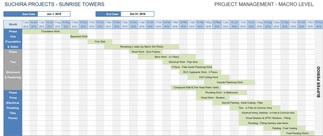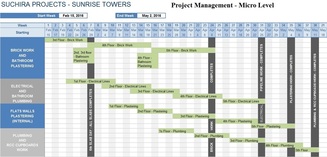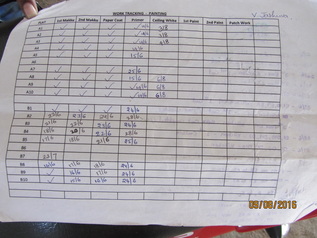Project Management Practices - in Construction
Purpose of the article: To let people/customers know about our effort and project management practices followed at SUNRISE TOWERS apartment construction.
Foreword: A 5-storey, 50-flat apartment building can be constructed in 2.5-3 years leisurely. However, by completing the construction in less time, lot of expenses can be saved on interest costs and this advantage can be passed to customers. Also, customers can occupy their flats without waiting for long periods.
When we targeted to complete SUNRISE TOWERS in 18-months period, lot of people (including experienced builders) said it is not possible. Few commented it as marketing publicity by builders. However, we have put in lot of effort for project management and successfully executed and showed that IT CAN BE DONE.
Foreword: A 5-storey, 50-flat apartment building can be constructed in 2.5-3 years leisurely. However, by completing the construction in less time, lot of expenses can be saved on interest costs and this advantage can be passed to customers. Also, customers can occupy their flats without waiting for long periods.
When we targeted to complete SUNRISE TOWERS in 18-months period, lot of people (including experienced builders) said it is not possible. Few commented it as marketing publicity by builders. However, we have put in lot of effort for project management and successfully executed and showed that IT CAN BE DONE.
 Project Schedule - Macro Level
Project Schedule - Macro Level
A - Project Timeline and Schedule - Macro Level
Similar to software projects in IT companies, list of events/works (in chronological order) are labelled with their start and end dates. Starting stage of works, like foundation and slabs, have to be done sequentially. However, works like tiles, outside plastering, water lines can be done in parallel.
After thorough study, list of works which can be done simultaneously are identified and combined into iterations. Finally, a project schedule is prepared at start of the venture with start and end date.
Similar to software projects in IT companies, list of events/works (in chronological order) are labelled with their start and end dates. Starting stage of works, like foundation and slabs, have to be done sequentially. However, works like tiles, outside plastering, water lines can be done in parallel.
After thorough study, list of works which can be done simultaneously are identified and combined into iterations. Finally, a project schedule is prepared at start of the venture with start and end date.
 Project Schedule - Micro Level
Project Schedule - Micro Level
B - Quarterly Project Schedule - Micro Level
On top level, below are the major divisions involved in construction work.
- Tapi/Masonary, Electrical, Carpenter, Plumbing & Sanitary Work,
- PoP Ceiling, Painting, Tiles, Earth & Concrete Work.
Most of these works can be done in parallel and inter-dependent. One work should not be stopped (or) waiting due to another pending work. These need to be identified early and planned in advance.
To avoid such delays, project schedule is prepared for each quarter / iteration. Each division mestri and supervisors are notified and discussed about future works to be done in each iteration. So, EVERYBODY KNOWS WHAT THEY HAVE TO DO IN NEXT THREE MONTHS :). They have to plan and prepare for it accordingly.
On top level, below are the major divisions involved in construction work.
- Tapi/Masonary, Electrical, Carpenter, Plumbing & Sanitary Work,
- PoP Ceiling, Painting, Tiles, Earth & Concrete Work.
Most of these works can be done in parallel and inter-dependent. One work should not be stopped (or) waiting due to another pending work. These need to be identified early and planned in advance.
To avoid such delays, project schedule is prepared for each quarter / iteration. Each division mestri and supervisors are notified and discussed about future works to be done in each iteration. So, EVERYBODY KNOWS WHAT THEY HAVE TO DO IN NEXT THREE MONTHS :). They have to plan and prepare for it accordingly.
 Work Tracking - Painting
Work Tracking - Painting
C - Work Tracking Sheets for Each Division
In a first of its kind, all mestris are surprised and happy to see such work tracking sheets, simple excel sheets :). Generally, daily work is recorded in notebooks, called DPR (Daily Progress Report). When work is going in such huge number of flats, its tough and confusing to track work status in notebooks.
As a solution, work tracking excel sheets are prepared for each work division with 50-flats (or) 50-rows. When a work is completed, it will be marked in the sheet with that date. It made life easy for supervisors and mestris, to track the work in flats. If any work is pending, they will be given priority.
In a first of its kind, all mestris are surprised and happy to see such work tracking sheets, simple excel sheets :). Generally, daily work is recorded in notebooks, called DPR (Daily Progress Report). When work is going in such huge number of flats, its tough and confusing to track work status in notebooks.
As a solution, work tracking excel sheets are prepared for each work division with 50-flats (or) 50-rows. When a work is completed, it will be marked in the sheet with that date. It made life easy for supervisors and mestris, to track the work in flats. If any work is pending, they will be given priority.

D - Training and Meetings
Supervisors are trained about project schedule, work practices, work tracking sheets, material data. When new work is started, supervisors and respective mestris are briefed by Site Engineer about work practices and work quality. People should adhere to the standards as it will be inspected by Site Engineer later.
Frequent meetings are held with mestris regarding short-term and medium-term goals. Material and labour requirement are planned as well.
Supervisors are trained about project schedule, work practices, work tracking sheets, material data. When new work is started, supervisors and respective mestris are briefed by Site Engineer about work practices and work quality. People should adhere to the standards as it will be inspected by Site Engineer later.
Frequent meetings are held with mestris regarding short-term and medium-term goals. Material and labour requirement are planned as well.
Afterword: In construction field, most of the workers are uneducated and simple-minded. They can not think far and doesn't understand works of low complexity. It requires lot of effort, meetings and continuous reminding by the Management, in order to achieve such goals. Above practices are much harder to implement than they look to be.
